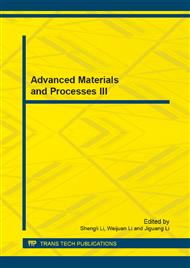p.708
p.712
p.718
p.726
p.732
p.737
p.741
p.746
p.751
The Experimental Study on Paint Removal from Aluminum Surface Using Ice Jet
Abstract:
Ice jet technology shows a promising prospect of application in surface cleaning and de-painting engineering because of its environmentally friendly feature. The main objective of this work is to present a deeply experimental study on the organic paint removal from aluminum alloy 2A12 substrates and the surface damage development using ice jets. The effects of ice blasting pressure and blasting time on de-painting and damage to the substrate were mainly concerned. It was shown that at blasting pressure of 0.2MPa, organic paint coatings were stripped from the 2A12 substrates. The paint coatings, moreover, were removed more effectively with increasing blasting pressure. Little changes of the roughness of the blasted substrate surface were observed. SEM images showed little plastic deformation at the blasting pressure of 0.5MPa existed on the surface. Whereas, a few of impact craters due to impact of high-velocity ice particles appeared at 0.7MPa for 7 seconds of exposure time with its number increasing obviously for 15seconds.
Info:
Periodical:
Pages:
732-736
Citation:
Online since:
September 2013
Authors:
Price:
Сopyright:
© 2013 Trans Tech Publications Ltd. All Rights Reserved
Share:
Citation:


